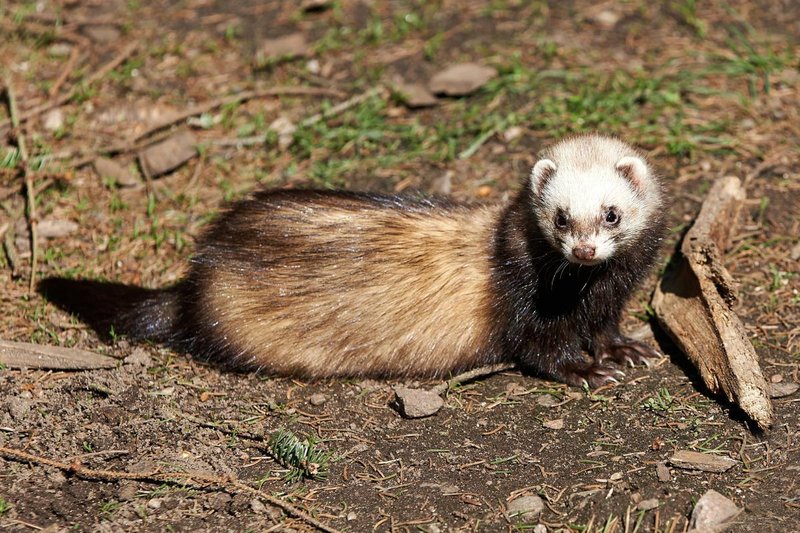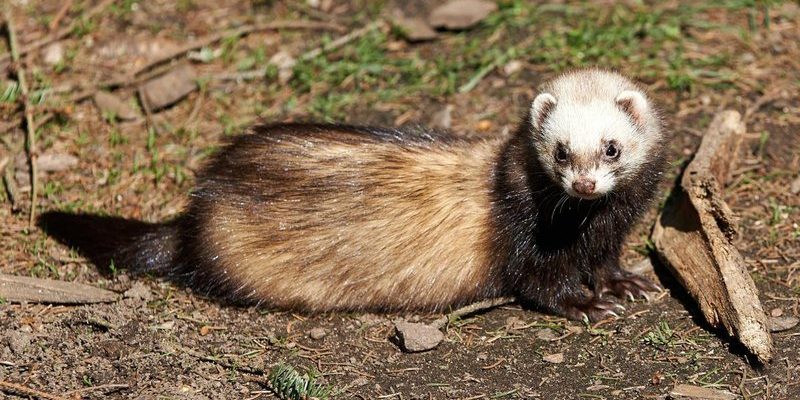
Picture this: you’re on a walk, and you spot a small creature darting through the underbrush. Is it a skunk? An opossum? Or maybe a funky little ferret? Identifying these critters can be tricky, especially when they sometimes look quite similar. Knowing what to look for can make all the difference when you’re trying to figure out what’s what in the animal kingdom. Plus, understanding these creatures helps deepen our appreciation for wildlife around us.
So, grab your favorite drink, and let’s dive into the world of animals similar to the skunk!
1. Opossums
You might be wondering how an opossum could resemble a skunk. Well, both animals often have a similar size and shape, as both are relatively small, about the same size as a domestic cat. Opossums are mostly grayish-white, but their fur can sometimes have a faint sheen, giving them a somewhat similar look to a skunk’s glossy coat.
However, here’s the thing: while skunks flaunt their bold black and white stripes, opossums are more subtle with their colors. If you catch a glimpse of an opossum, pay attention to its face. They have a long, pointed snout and a distinct, rat-like tail, which is a dead giveaway. A skunk, on the other hand, has a short, bushy tail and a rounded nose.
Additionally, when it comes to behavior, they couldn’t be more different. Opossums are known to play dead when threatened—a tactic they’ve mastered over time. Meanwhile, skunks prefer to spray as their first line of defense!
2. Ferrets
Ferrets are cute little creatures with a lot of personality, and believe it or not, they share some visual similarities with skunks. Both have elongated bodies, short legs, and a playful attitude that can endear them to many. Ferrets typically have a tan or brown coat, but their white bellies and dark “mask” around their eyes can give them a striking resemblance to skunks—especially if you spot them at a quick glance.
To tell them apart, focus on the size and shape. Ferrets are generally smaller and much more slender than skunks. They also lack the distinctive striped pattern that skunks are known for. Additionally, ferrets have a much more vibrant and energetic demeanor. While skunks are more docile and prefer to avoid confrontation, ferrets are known for their curious nature and love to explore their surroundings.
3. Badgers
Now, let’s talk about badgers. These burrow-dwelling creatures, found in various regions, have sturdy bodies and short legs, making them somewhat reminiscent of skunks. Both animals share a similar habitat, often seen roaming fields or forests. While badgers usually sport a grayish fur coat with characteristic black and white facial markings, there are some similarities in their general shapes.
To differentiate a badger from a skunk, take a look at their build. Badgers are more robust and muscular than skunks, with broader heads. Their fur is also distinctly different, lacking the unmistakable striped pattern that skunks flaunt. Plus, badgers are more aggressive than skunks—so if you encounter one, it’s best to give it plenty of space!
4. Weasels
Weasels are another animal that can be mistaken for skunks due to their size and body shape. Like ferrets, they have elongated bodies and short legs. However, weasels often have a more slender build, especially when compared to the stockier skunk.
In terms of coloration, weasels typically sport a rich brown coat, which can turn white in winter for some species. This seasonal change can lead to confusion, especially in snowy environments. But fear not! If you look closely, you’ll notice that weasels have a different facial structure and often sport a more pointed snout than the rounded nose of a skunk. They also have less bushy tails, which adds to their sleek appearance.
5. Raccoons
Raccoons and skunks share a lot in common, especially when it comes to their habitats and even behavior. Both are nocturnal critters, often rummaging through garbage cans and looking for food at night. A raccoon’s grayish-black coat can give it a similar appearance to a skunk except for the notable black “mask” that raccoons are famous for.
To tell them apart, look closely at their tails. Raccoons have bushy tails with distinct black stripes, while skunks have solid black tails with white stripes. Also, raccoons tend to be a bit larger and fluffier than skunks, and their facial markings are more pronounced than any markings you’d find on a skunk.
6. Minks
Minks can be often confused with skunks, especially if you spot one quickly. These sleek animals also have elongated bodies and typically sport thick, luxurious fur that could remind you of a skunk’s coat. Minks come in various colors, including dark brown and black, sometimes resembling a skunk from a distance.
However, if you look closely, you’ll spot some key differences. Minks are usually much smaller than skunks. They also have shorter legs and a much longer body. You’ll also notice that minks have a more pointed face, without the characteristic wider nose that skunks have. Minks are more aquatic than skunks, too; you might find them near streams or rivers.
7. Groundhogs
Groundhogs, also known as woodchucks, might not look like skunks at first glance, but they do share a similar size and shape. Groundhogs are stout creatures, and their fur can sometimes resemble the darker patches of a skunk. However, the resemblance usually ends there.
One clear distinction is their coloration. Groundhogs typically have a brownish coat, whereas skunks are easily recognizable with their black and white fur. Groundhogs also have a more rounded face and a thicker appearance compared to skunks. They’re more herbivorous, primarily munching on plants, while skunks have a more varied diet, including insects and small mammals.
8. Cats
Believe it or not, domestic cats can sometimes resemble skunks, particularly if they have black fur with white markings. Some cats have white ruffs that look similar to a skunk’s stripes. In the wild, black cats can occasionally throw people off when spotted in low light.
To differentiate between the two, pay attention to the tail and body structure. Skunks have a bushy tail that is distinctive and usually has a white stripe down the middle. Cats, meanwhile, have long, sleek tails that taper off. Plus, cats are generally much more agile and graceful than skunks.
9. Squirrels
Squirrels might seem like an odd comparison, but hear me out! Certain species, particularly the black squirrel, can look somewhat similar to a skunk from a distance. Both animals have small, rounded bodies and bushy tails, making them appear alike if you catch them hopping through the trees.
However, it’s pretty easy to tell them apart when you take a closer look. Squirrels have a more slender build, and their tails are shaped differently. Plus, they have longer, more pointed noses compared to a skunk. Also, squirrels are much more agile and known for their acrobatic skills, often leaping from branch to branch.
10. Hedgehogs
Lastly, let’s talk about hedgehogs. While they look quite different at first glance, their small size and round bodies can draw comparisons with skunks. Hedgehogs have spiny fur that may remind you of the skunk’s thick coat.
However, they are far more distinct when you see them closely. Hedgehogs are notably smaller and covered in spines, which sets them apart from the smooth fur of a skunk. Plus, hedgehogs have a pointier snout and a much different shape overall. While skunks are often on four legs, a hedgehog rolls into a ball when threatened—quite the different defense strategy!
In summary, while skunks have some look-alikes in the animal kingdom, each of these creatures has its unique traits that set them apart. Understanding these differences can deepen your appreciation for wildlife and help you identify what’s roaming in your backyard. Next time you spot a small animal, you can confidently decide whether it’s a skunk or one of its interesting lookalikes!

